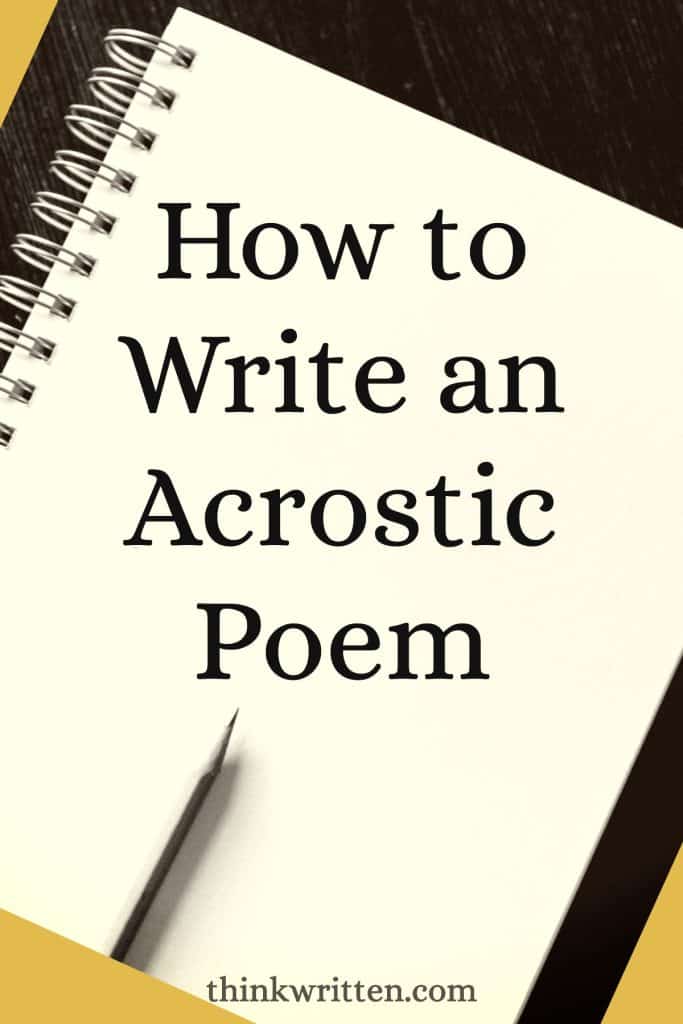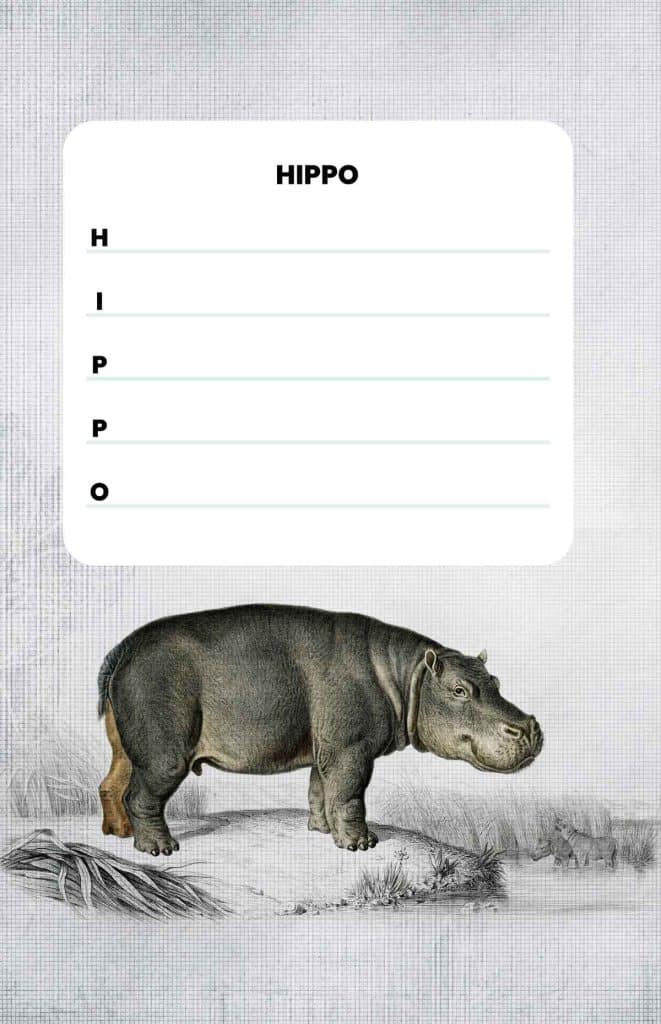We may receive a commission when you make a purchase from one of our links for products and services we recommend. As an Amazon Associate we earn from qualifying purchases. Thank you for support!
Acrostic poems are fun to write and are a great way to practice your writing skills and creativity! Today we’ll share four different types of acrostic poems and some tips for how to write your very own acrostic poems.
What is an acrostic poem?
Before we start writing acrostic poems, it’s important we first understand what they are and how they work!
An acrostic poem is a type of poem that is created by choosing a word or phrase and writing it out vertically so that each letter of the word or phrase is on its own line. Each line of the poem is based on a letter of the main word.
In some ways, an acrostic poem is like an acronym, where each letter stands for a word. Of course, with acrostic poetry, you can use as many words and phrases as you like!
It’s easier to understand what an acrostic poem is with a visual example, so here is what it would look like if you wrote the word “Tiger” vertically to use each letter of the word for the lines in your poem.

The standard acrostic poem uses each letter of the word to be the first letter of each line of the poem. However, this is not the only type of acrostic poem available to write!
Types of Acrostic Poems
Here are a few examples of different acrostic poem formats:
Standard Acrostic – The line letter is the first letter of the word or phrase it spells out.
Double Acrostic – In a double acrostic, the line letter is the first and last letter of the word or phrase it spells out.
Middle Acrostic – The line letter is located somewhere in the middle of the word or phrase it spells out.
End Acrostic – The line letter is the last letter of the word or phrase it spells.
The standard acrostic poem is the easiest of the 4 types of acrostic poems to write, so in this post, we will focus on that one – once you practice writing a few standard acrostic poems, you’ll be ready to try the more advanced formats!

Step 1: Choose a Word or Phrase to Use for Your Acrostic Poem
The very first thing you will want to do is choose a word or phrase to use for your acrostic poem. This word will be the title/subject of the poem, and will also guide you to create each line of the poem.
Things to Consider When Choosing a Word
You can choose any word or phrase you like, but there are a few things you may want to take into consideration when selecting your word.
How long do you want your poem to be? Shorter words will be shorter poems – longer words and phrases will be longer poems.
What Message Do You Want to Send? Your poem can be about anything, but you might want to think about the tone of the poem and what message it will convey to your reader.
Who Is Your Target Audience? Are you writing poetry just for fun? Or are you writing to be published in a magazine? Thinking about your audience and what subjects they are interested in can help guide you in choosing a word.
How Experienced Are You in Writing? If you are a teacher with younger students or you are new to writing poetry, you’ll probably want to start out with shorter words that are only between 4-7 letters long. If you’ve been writing for a long time or a secondary teacher, longer words will give you more opportunities to be creative!

Quick + Fun Ideas to Choose Your Word for an Acrostic Poem
There are 171,476 words in the English dictionary – which means you have a lot of options! Sometimes this can be overwhelming though! Here are some ideas to narrow down the selection:
Your Favorites: If you have a favorite color, food, word, place, animal, holiday, or season, you could write a poem about that or something related to it.
Your Name: Your name is also a great choice for your first acrostic poem!
Name of a Celebrity or Friend: You could also pick a name of a celebrity or a friend to write about.
A Place: Places are also great words to choose – whether it’s the kitchen, the library or under the bed!
If you really can’t decide on a word, take any book you have nearby and open it up to a random page – the first word you see will make for a great poem!
Don’t get too hung up on trying to choose a word – remember that you can ALWAYS write multiple poems using different words!
If you need some more ideas, here are some posts on our site that can help inspire you for what to write about:
We will also be adding many one-word prompts and some different theme ideas to inspire you in the next few weeks!
Step 2: Brainstorm for Things You Associate With the Subject

After you choose a word to use for your poem’s title and subject, brainstorming a quick list of things you associate with the subject will help make the writing process much easier!
In our tiger poem example, we’d want to think about what we might associate with a tiger. Some things I think of when I think of tigers:
- Feroicious
- Wild
- Orange
- Stripes
- The Zoo
- The Jungle
- Majestic
To come up with associations for the subject of your poem, think about things that describe your subject.
A good rule of thumb when trying to write a description is to refer back to your five senses. Think of what the subject looks like, how it smells, how it tastes, how it sounds, and the way it feels.
You will also want to consider its physical characteristics. The color, size, shape, and texture are also good details to use when describing something.
If you are writing about a more abstract concept such as an emotion, you can still use physical traits – what does happiness taste like? What shape is anger? This is a great way to use metaphors in your writing!
Another thing to consider is how the subject impacts you emotionally. What feelings do you feel? If I were to encounter a tiger in my backyard, I’d probably be scared!
It can be helpful to make a list of all these associations before you start writing your acrostic poem. Don’t worry too much in the beginning about coming up with words that start with the letter of each line – just get a list of any words you associate with the subject.
Step 3: Begin Writing Your Acrostic Poem
After you have picked your word and you have a list of ideas for things you associate with the subject, it’s time to get writing!
Begin by writing each letter of your selected word down the page vertically. Each letter should have its own separate line or space on the page.
Next, you will want to write your lines of the poem so that each line begins with the letter written on the line.
After you practice writing a few standard acrostic poems, you can then experiment with using any of the acrostic styles we went over earlier, or even combine a few styles if you’re up for the challenge. There are really no rules when it comes to writing acrostics!
To write each line, go back to your list of ideas and associations with the subject and see if there is a way to fit them to start with the first letter of each line.
For example, with our Tiger Poem:
Tiger, An Acrostic Poem
Terrifying and Wild,
If I were to see a tiger
Glaring at me from my backyard –
Eek! I would most certainly
Run!
Many acrostic poems are simply lists of adjectives that describe the subject – and this is perfectly okay! But sometimes it can be more fun to write your poem if you include some action as I did with my tiger poem. Either way is fine, and like I’ve said a few times – there are hundreds of thousands of words, so you can always write another one if you’re not happy with your first attempt!
With some practice, you can also incorporate some other writing techniques in your acrostic poems, such as using alliteration, allusion, and onomatopoeia.
Step 4: Revise + Edit Your Poem
As we’ve covered many times in our posts about the writing process, the first thing you write isn’t always the final work – usually it’s just a first draft!
Revision is when you refine the words you use and the way you say it. Maybe in our tiger poem, for example, I might want to change one of the words I use or rephrase one of the lines.
Editing your poem means you make sure there are no major spelling, grammar, or punctuation errors. Poetry allows you a little more freedom with these “rules” – as the saying goes, know the rules so you can break them!
Still, you want to make sure above all that your poem has clarity – does it convey a message or a mood to the reader? Is it easy to understand? Is there anything that might confuse the reader?
After your poem is finished, you are ready to share it! You can share with family and friends, your writing group, or even consider publishing an entire book of your poems.
Step 5: Gather Ideas + Resources for Your Next Acrostic Poem!
With these tips for how to write acrostic poems, you are sure to be writing them in no time at all. Here are some additional ideas + resources that can be helpful when writing poetry:
Alphabetical Word Lists: If you struggle with finding the right words to use when starting the lines of your poem, alphabetical word lists can be VERY helpful to find unique words to use. I will admit with my tiger poem that I wrote above I needed to look up some ideas for words that start with G and E!
RhymeZone Dictionary and Thesaurus: I love this dictionary because it is great for finding rhymes AND synonyms while writing.
Journey Into Dreams Dream Dictionary: I created this dictionary to share the symbolism, meanings, and associations for different words. While it focuses on dream interpretation, if you are looking for ways to make your poems more powerful and meaningful, this is a great way to be inspired!
Any kind of dictionary is great to have, whether it’s an online dictionary or one you keep on your desk – You will find a paradise of all the words and descriptions you could ever need.
Visual Prompts: As acrostic poems are somewhat a visual form, looking at a picture to inspire your poem’s subjects and lines can be very helpful, especially if you are looking for words. Sites like Unsplash.com and Pexels.com are great sources for free photos you can be inspired by.
Keep a Journal! If you aren’t keeping a journal as a writer yet, you most definitely should be! See our tips for creating a writer’s notebook here to be inspired!
Writing acrostic poems can be so much fun, and there really is no limit to what you might create with this poetry writing technique.
I hope this post helps you in your writing journey and inspires you to create your own acrostic poems. If you have any tips for writing acrostic poems to share, or would like to share your own acrostic poems, we would love to hear from you in the comments section below!


